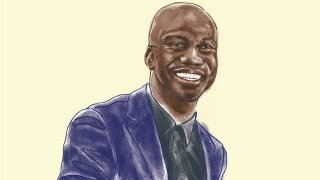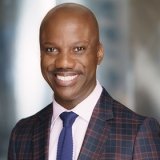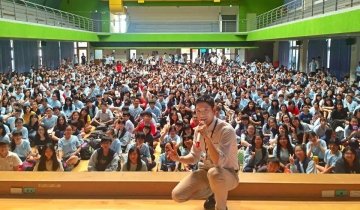Your term as president of the American Educational Research Association (AERA) is concluding soon. What are some of the accomplishments of which you are most proud?
I am most proud of the appointments that I’ve made. The one major responsibility of the president is to appoint people to lead and serve on a range of committees and important things in the association. Literally a third of the appointments are made by the president, which is an enormous task, but I'm really, really proud of the diversity of my appointees—not just to positions of service on committees but also leadership of those committees.
Second, I’m already feeling incredibly proud of the association’s very first virtual annual meeting [which takes place in April]. Normally, the AERA conference brings somewhere between 15,000 and 18,000 people together. Having a virtual conference could have been an absolute headache and nightmare. But for me, weirdly, I’m excited because it affords us an exciting opportunity to try out some technological innovations that we otherwise would not have experimented with. It allows us to be much more thoughtful about accessibility in terms of affordability.
But I also mean accessible in a second way. With a 15,000-to-18,000-person conference, sessions are oftentimes at a convention center. Plus, attendees need to stay in hotels. So for colleagues with physical disabilities, there were mobility challenges. I actually am feeling really good that we’ll have a virtual space to create a much more physically accessible conference experience.
Looking ahead, what are some areas of education in urgent need of further research?
The pandemic will leave us with much to study for many, many years. It’s kind of like scholars in other fields who study the impact of the Great Depression or the 2008 recession. Even in 2020, economists were still studying the effects of the 2008 recession. In that same way, education researchers will study the effects of this pandemic on schooling and on educational outcomes. I honestly think that a whole genre of research will emerge from the pandemic aftermath.
You are a member of Gov. Gavin Newsom’s statewide task force on racial equity, higher education and COVID-19 recovery. What is the task force’s mission?
To fast-forward ahead and anticipate the inequities that will await us on the other side of the pandemic. And to strategically get ahead of those as opposed to waiting until we’re at the end of it and then have to clean up.
What are some of the inequities caused by the pandemic?
One is student access to reliable high-speed internet. Black and Latinx students, lower-income Asian-American students and certainly Indigenous students have had inequitable access to Wi-Fi. That, for sure, has compromised their ability to be engaged learners. Another, certainly, is that there were already students who were housing- and food-insecure before the pandemic. With surging rates of unemployment, they’re even more vulnerable. Those are two that immediately come to mind.
Are there any issues that are unique to California in terms of inequities caused by the pandemic?
The scale of the state makes the project of COVID-19 recovery especially massive and daunting. I don’t mean to suggest that small states won’t have their hands full with recovery efforts as well, but this is a really big, racially diverse state. The pandemic has affected White Californians and people of color in California in lots of ways. But in almost every one of those ways, the effects have been disproportionately devastating for people of color in our state. So, therefore, it’s going to be especially important to not attempt COVID recovery in a raceless way.
You gave testimony to the U.S. House of Representatives on COVID-19 and safely reopening college campuses, and discussed the need for financial support for chronically underfunded minority-serving institutions. Why is that so important?
Because in moments of economic distress, almost always it is the institutions that disproportionately enroll and educate students of color that are most devastated. When there is a recession or a moment of economic stress in the country, economists and others don’t put equity at the forefront of their analyses and their prescriptions for how we deal with it. What ends up happening is that the schools and communities that were already poorest and most underserved are impacted most.
I would argue community colleges, historically Black colleges and universities, and minority-serving institutions ought to be first in line when it comes to higher education policymaking and investment in COVID-19 recovery. Those institutions disproportionately enrolled [minority] students whose family members have been most terribly affected by the pandemic.
Historically Black colleges and universities, from their inception in the 1800s, have been terribly underfunded, especially the public ones. So we can’t expect them to produce the same kinds of outcomes as predominantly White institutions, because they weren’t starting from the same place, in terms of resources. We have to repair historical negligence and harm in this moment as we attempt to help those institutions bounce back from the inequities that the pandemic further exacerbated.
[Harper further outlined racial equity implications of reopening college and university campuses in an article for the American Journal of Education.]
What are some of the ways that we can repair some of those historical inequities?
I’m a huge proponent of reparations. Most people talk about reparations as payments to individuals and families. I’m not opposed to that, but I get more excited about reinvestment of federal and state resources into institutions and businesses that narrowly and predominantly serve Black and Brown communities. When you ask how to repair historical inequities, it would look like a tremendous federal stimulus for HBCU and minority-serving institutions and community colleges.
Do you see hope for that kind of funding?
I do. With Kamala Harris in the White House as a graduate of a historically Black university, I am extremely optimistic that she—and certainly President Biden and Secretary of Education Miguel Cardona—will pay far more attention to HBCUs than have previous administrations. With Dr. Jill Biden in the White House as a community college faculty member, community colleges, I think, will finally get the attention they deserve.
“I’ve been on a lifelong journey to more deeply understand what manufactures and reproduces those kinds of inequities.”
The Race and Equity Center hosted Unfinished Business—Race and Equity in America in October. Can you describe the summit and tell me about your experience?
It was a beautiful collaboration between the USC Race and Equity Center, the Schwarzenegger Institute and the Safe Communities Institute, which are in the [USC Sol Price School of Public Policy]. We did it on Twitch, which is the world’s largest live-streaming platform.
Over three days, we had a series of interviews and panels on racial equity topics including race and voting rights, race and policing, certainly education and race, race in Hollywood. And we had lots of elected officials. This event was decidedly bipartisan. For example, [former Secretary of Housing and Urban Development] Ben Carson was on one of the panels. We also had [former senior adviser] Valerie Jarrett and Attorney General Eric Holder from the Obama administration join us. We had Usher and Saweetie, who is this incredible rapper and [USC Annenberg School for Communication and Journalism] alum. It was a really amazing, inclusive and dynamic three days of not just conversations but also action-oriented, agenda-setting panels around how to move our nation toward a more racially equitable present and future.
Were there some takeaways that stuck with you from the different conversations, or the experience as a whole?
We did not want this to be an occasion where we get together and just rehash racial problems. We communicated to [speakers and viewers] that we’re going to get together to think about solutions. So, just the whole mood and vibe was upbeat. It was serious; at times it was critical. But it was also forward-thinking and optimistic. So many people have written us to tell us just how motivated and inspired they were; I’ll never forget that experience. I’ll also say that in addition to being inclusive of people from a range of political perspectives and industries, it was also beautifully intergenerational. We had young activists and young celebrities. We created a platform for them to have a voice. And I was so inspired by the depth and maturity of their thinking.
[According to Harper, the Race and Equity in America summit was viewed by 4.3 million online users over three days.]
You were a member of the National Education Policy team for the Joe Biden/Kamala Harris presidential campaign. What was your role?
Specifically, I was a member of the educational equity subcommittee. In that committee, we had three responsibilities. First, we helped create a set of research to inform very credible talking points for now-President Biden and Vice President Harris when they were on the debate stages and traveling and making speeches. We equipped them with facts and data about education. The second thing was to inform the day-one executive actions that President Biden would take. And then the third was to help set an agenda for the first 100 days of a Biden presidency, specifically on education issues.
And what was your experience like?
It felt so consequential. When I was invited to be on it, and the invitation specified what we would do, I immediately started thinking about, if I could get just one thing done in this in this experience—I mean, I wanted to get a lot done—but if I could get one thing, what would it be? At first, it was to help historically Black colleges and universities and minority-serving institutions and community colleges get more resources. But then there was this ridiculous executive order that President Trump issued that banned diversity training. That executive order was incredibly stressful and disorienting for lots of K–12 school districts and colleges and universities across the country. So that was going to be my second-highest priority—to get that god-awful, ridiculous executive order overturned. It was overturned! It’s gone. We got that done. It was a thing that I cared so passionately about, and I get to now say that I worked on it.
I’m certain that our first 100-day plans will be taken seriously by this administration. It includes some serious emphasis on [community colleges, historically Black colleges and universities, and other minority-serving institutions], so I'm certain that there’ll be other moments of serious celebration for me as I see those ideas unfold.
You were born and grew up in Thomasville, Georgia. How did your early life shape your approach to education?
I grew up in a small, rural, racially segregated town. There was tremendous racial inequity and racial stratification. What I mean by that is, I noticed fairly early in my life that most of the White people in my town seem to be middle class or wealthy. They were in charge of things. They were the leaders of most things. Black people in my community, including my family, we were overwhelmingly poor, lower-income people. I noticed that. As a child, obviously, I didn't have the analytical tools to make sense of it. So, you know, in some ways, I’ve been on a lifelong journey to more deeply understand what manufactures and reproduces those kinds of inequities.
One of the things that I knew was that my family and other Black families were not poor because we wanted to be. We were also not poor because we lacked ambition, or because we refused to work hard. I somehow knew that there were larger structural and systemic forces.
In my town, in my high school specifically, we always had two homecoming queens, one Black and one White. We’re not talking about the 1950s. This was the ’90s. And it was a thing that was never talked about. It just always happened. The election results for homecoming queen always yielded this result. You know, that informs the work that we do at the Race and Equity Center, where we force people in organizations, schools, universities and communities to actually talk about race. There are these racialized things that are hiding in plain sight—or sometimes not hiding, actually—that are very much visible to everybody but nobody’s talking about it. I have been on a mission throughout the entirety of my career to facilitate opportunities for people to productively talk about the things that they have been intentionally avoiding as it pertains to race.





